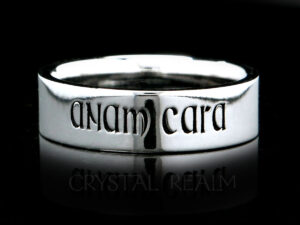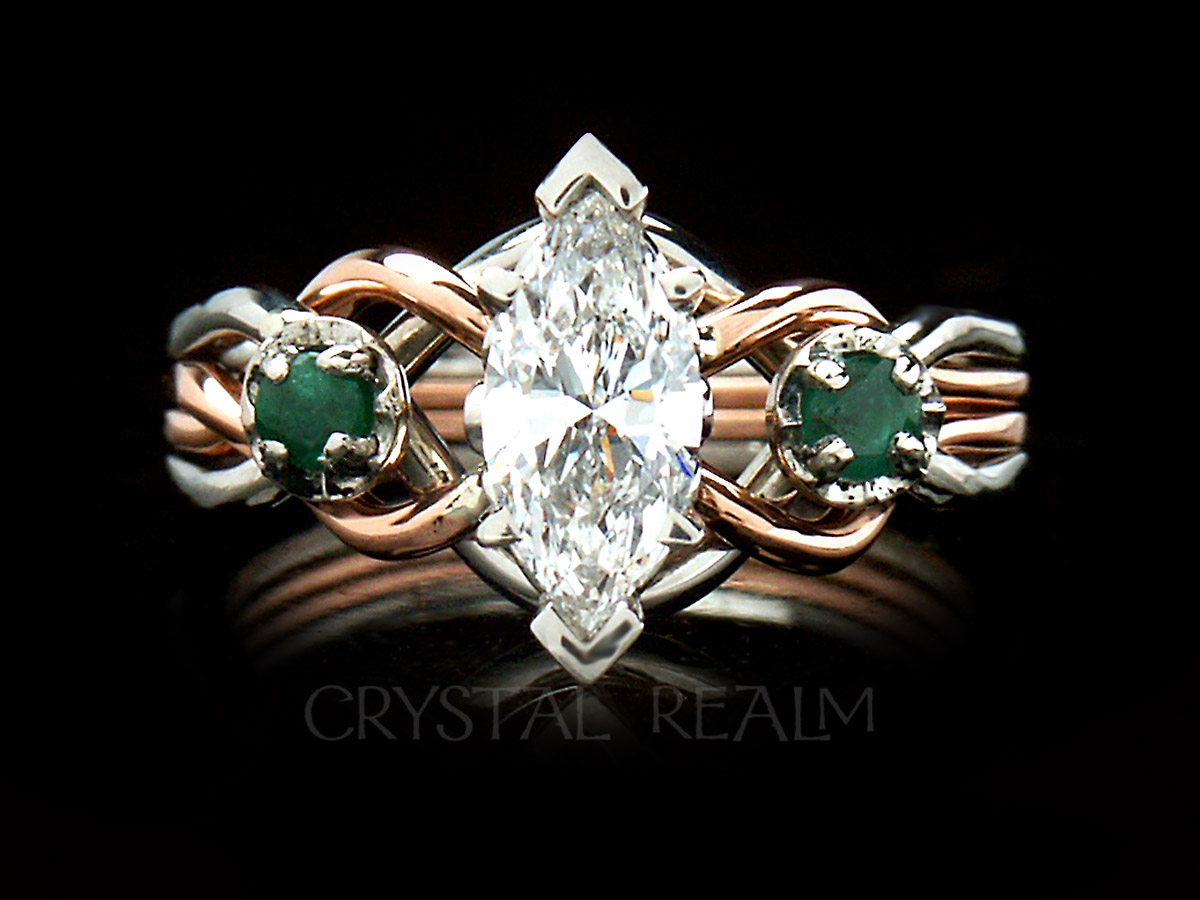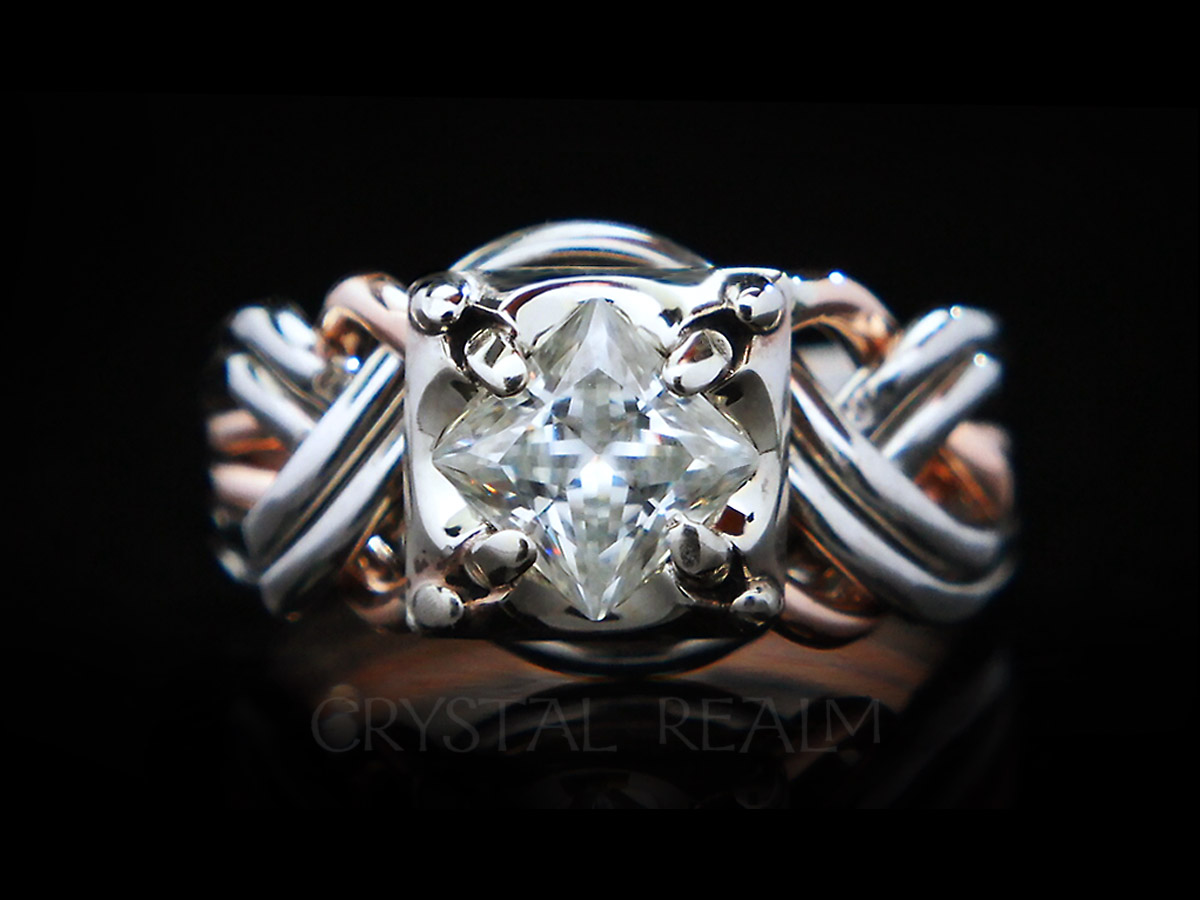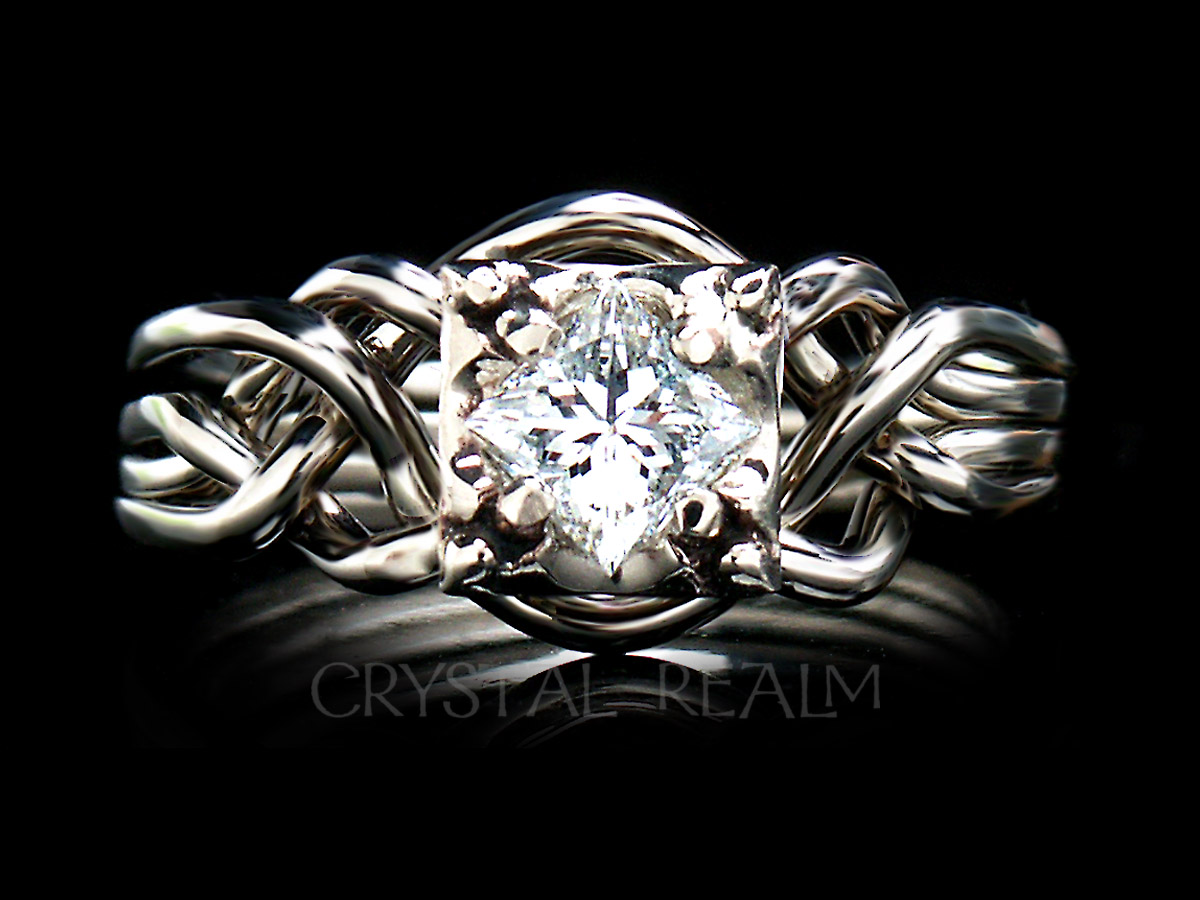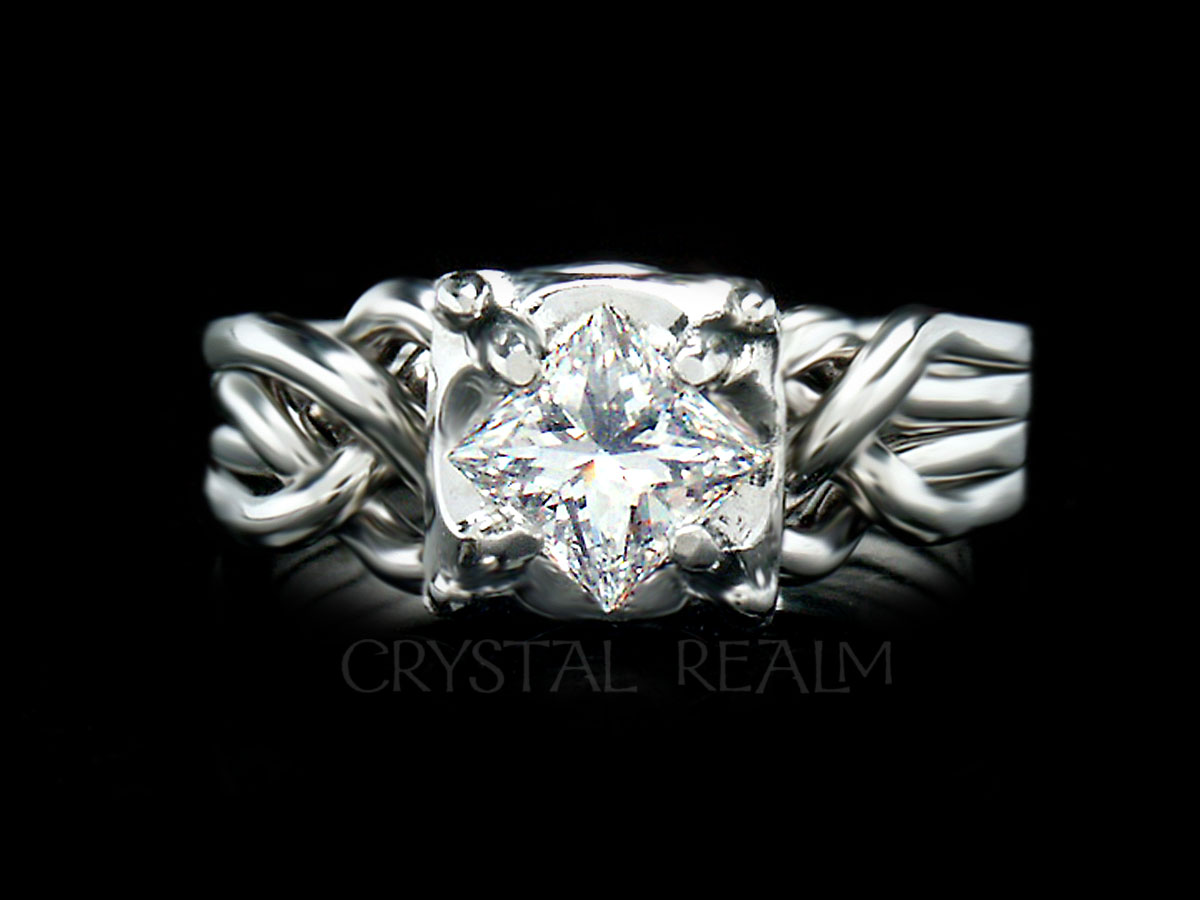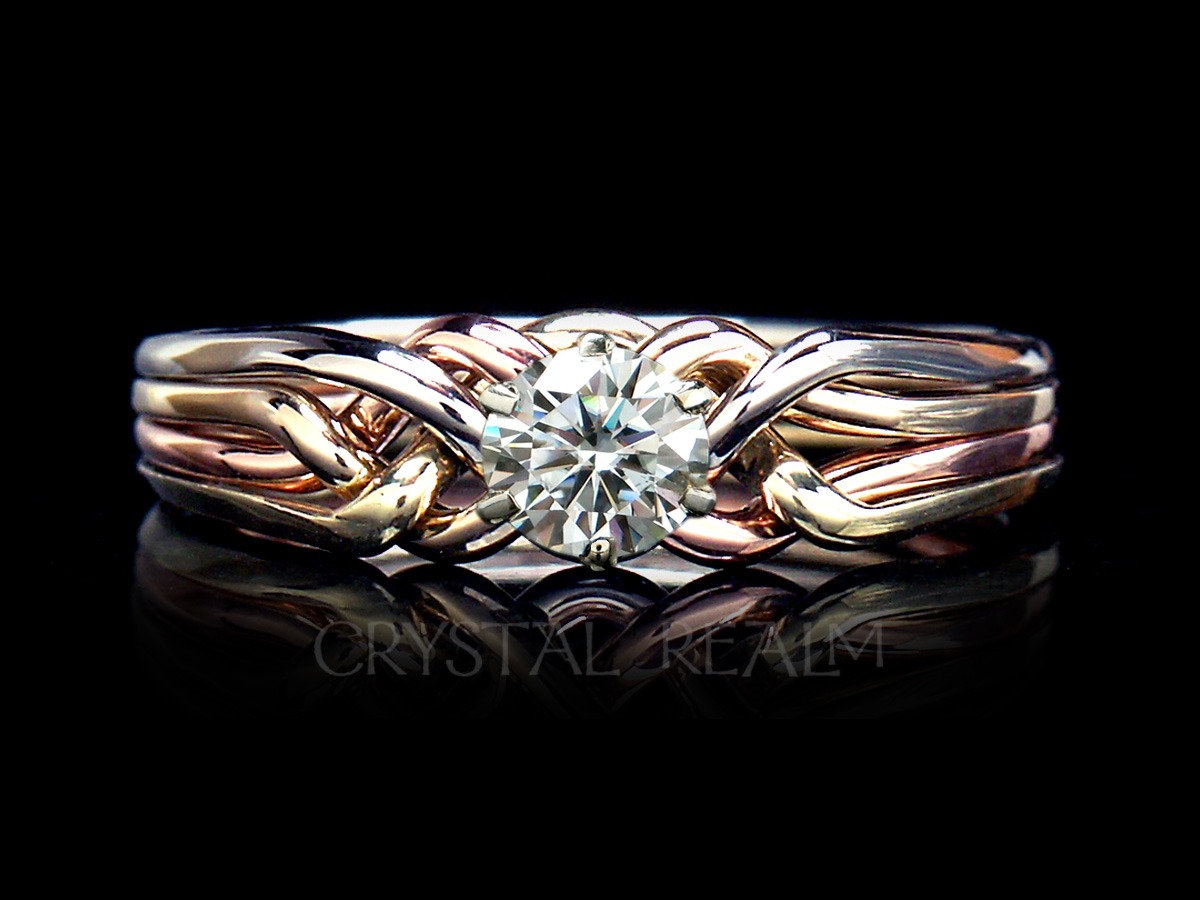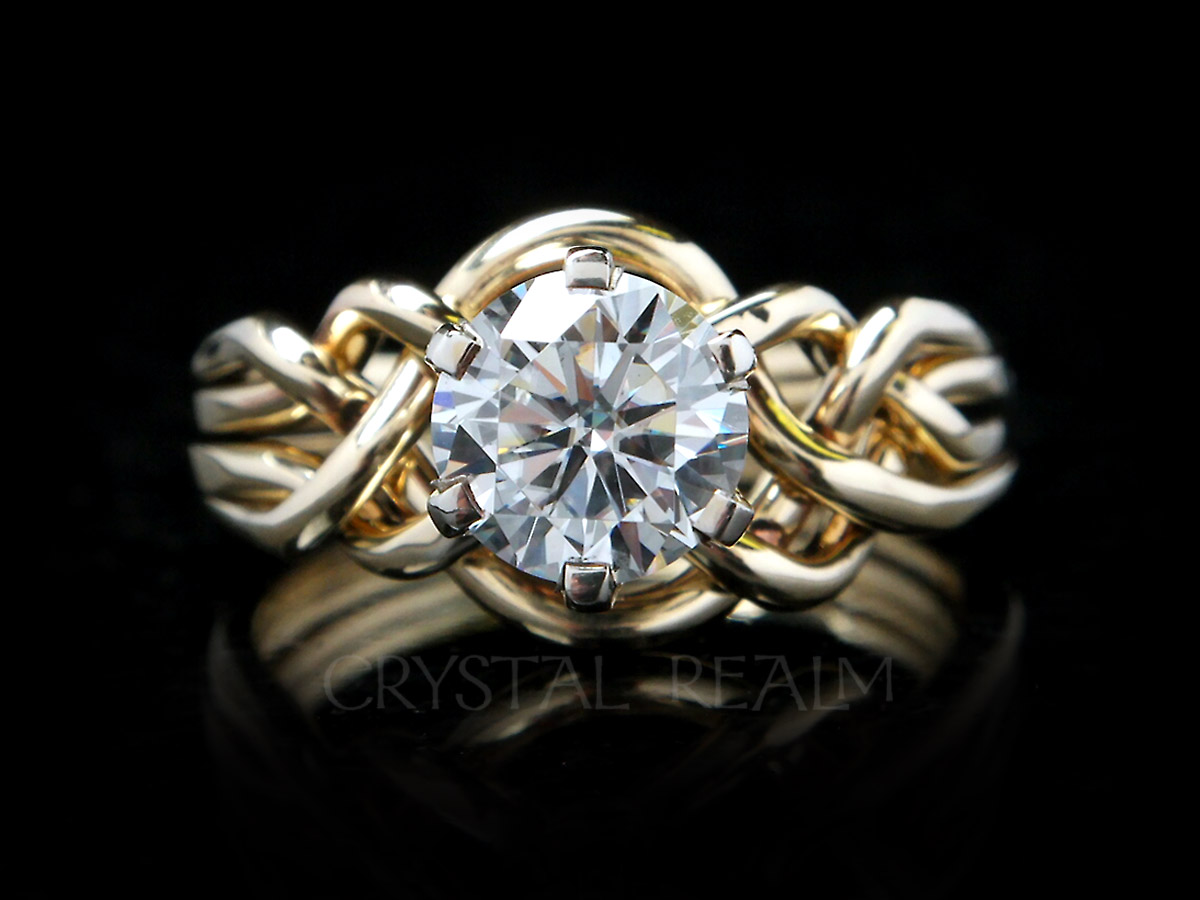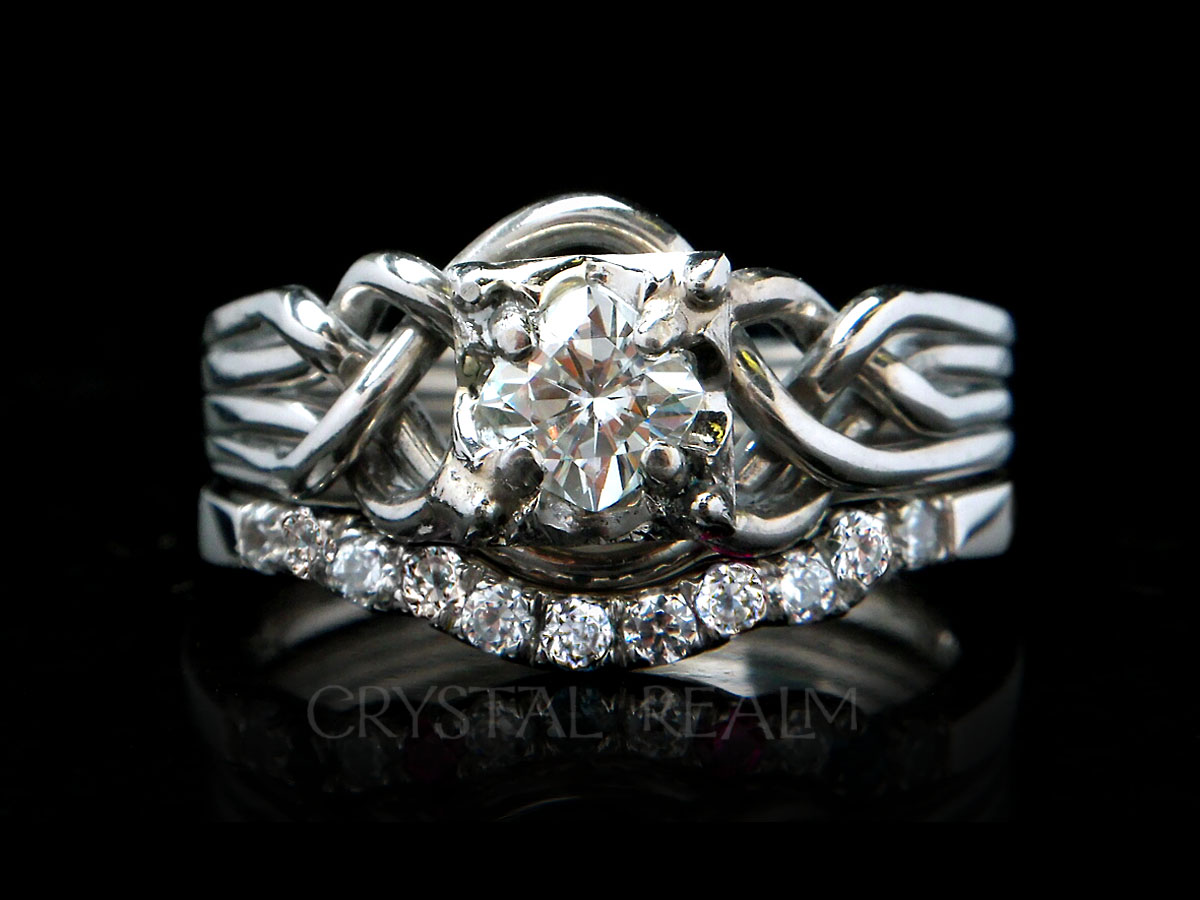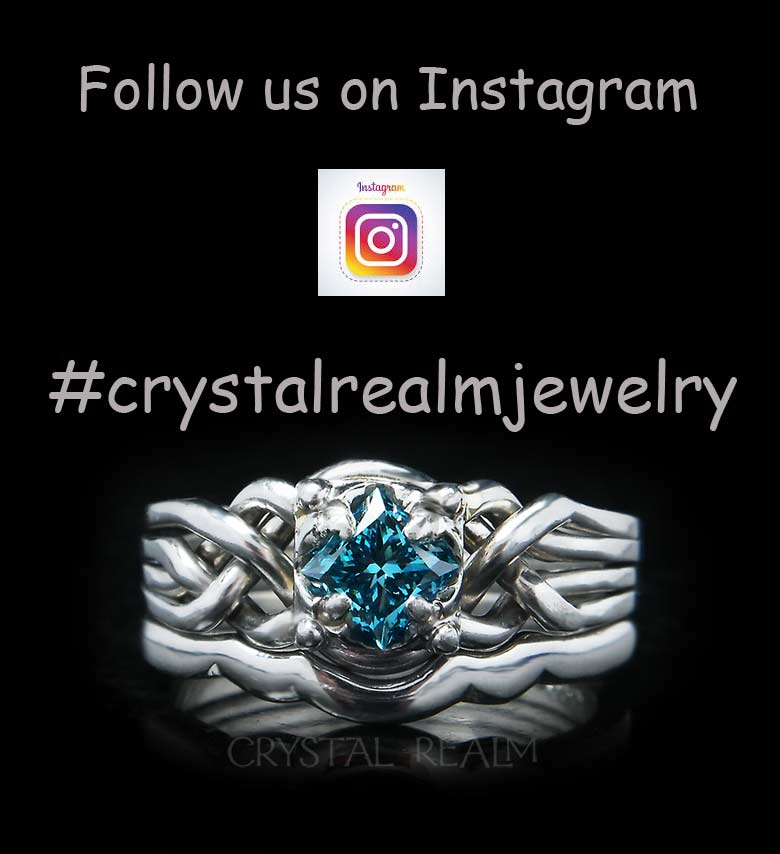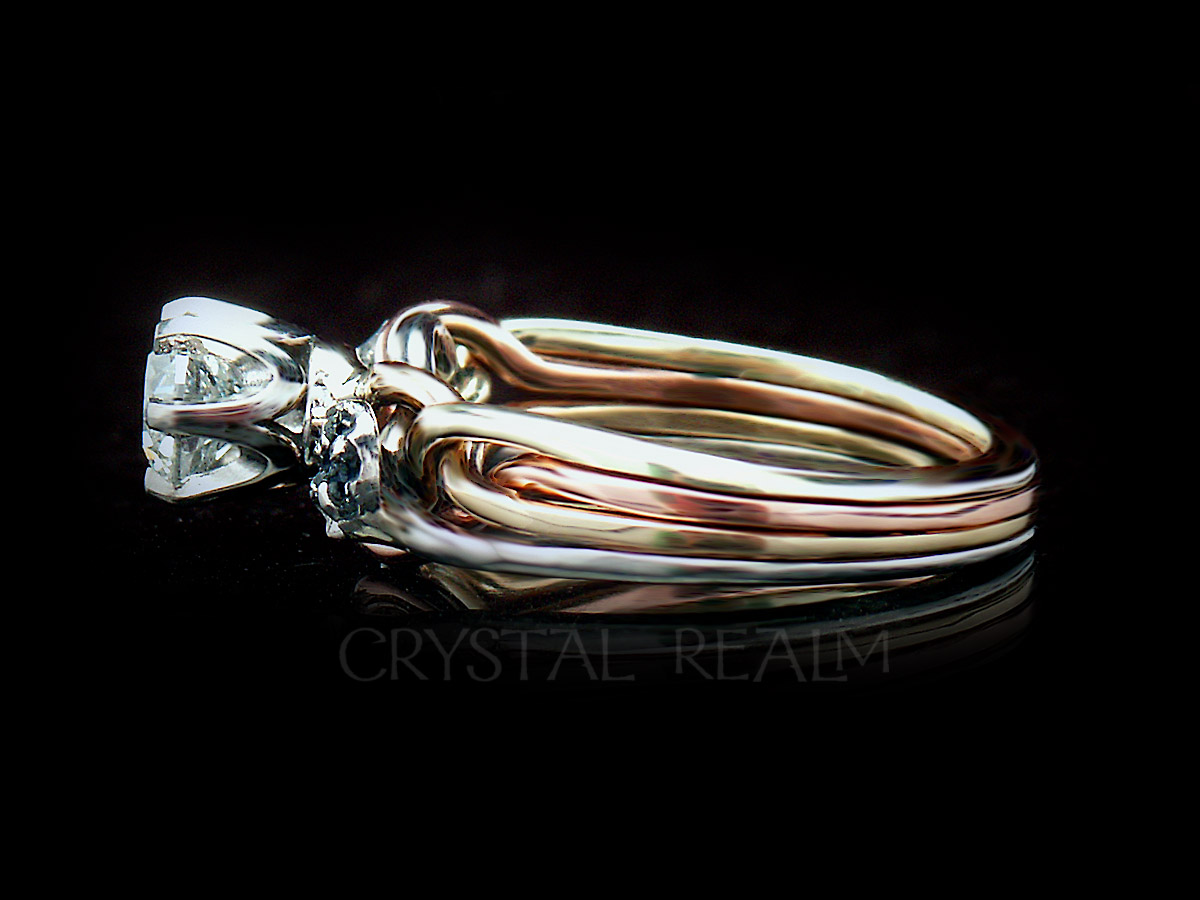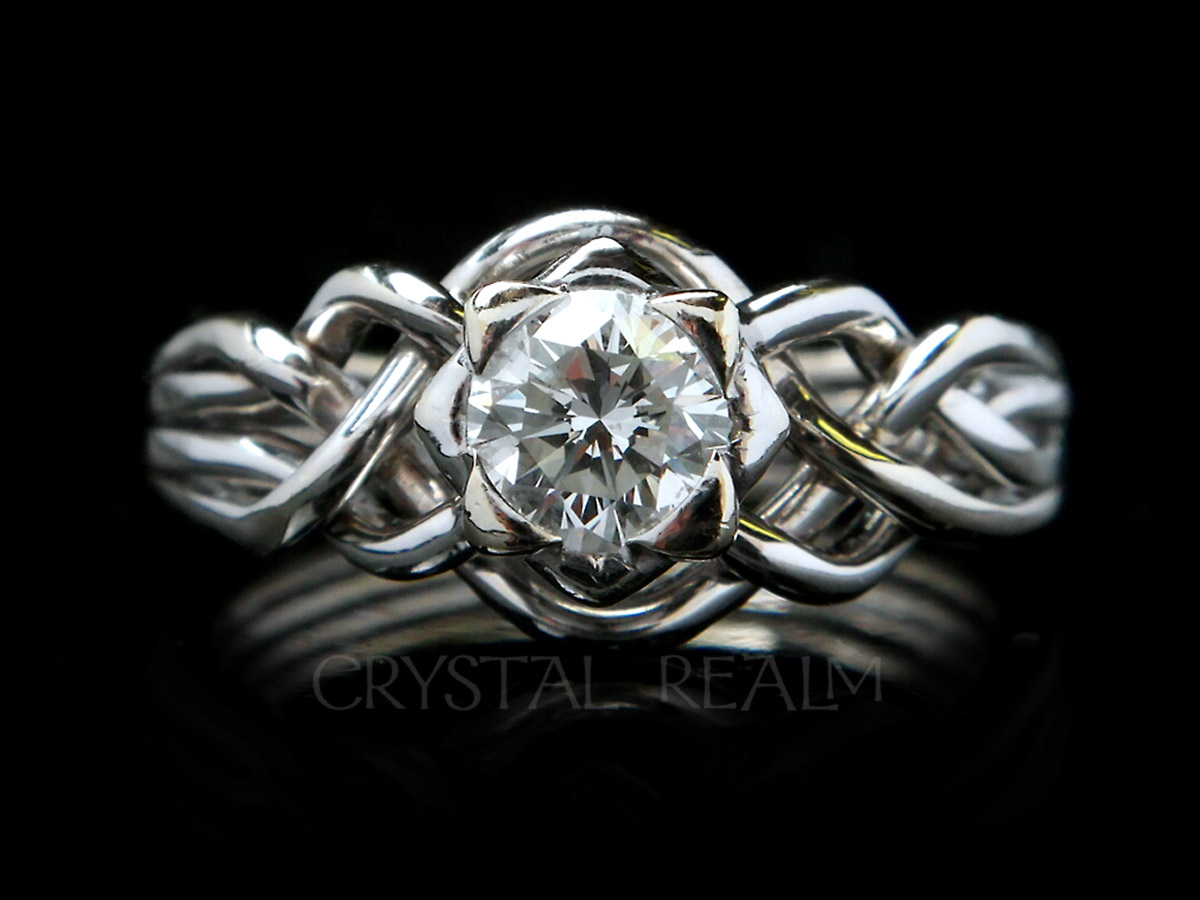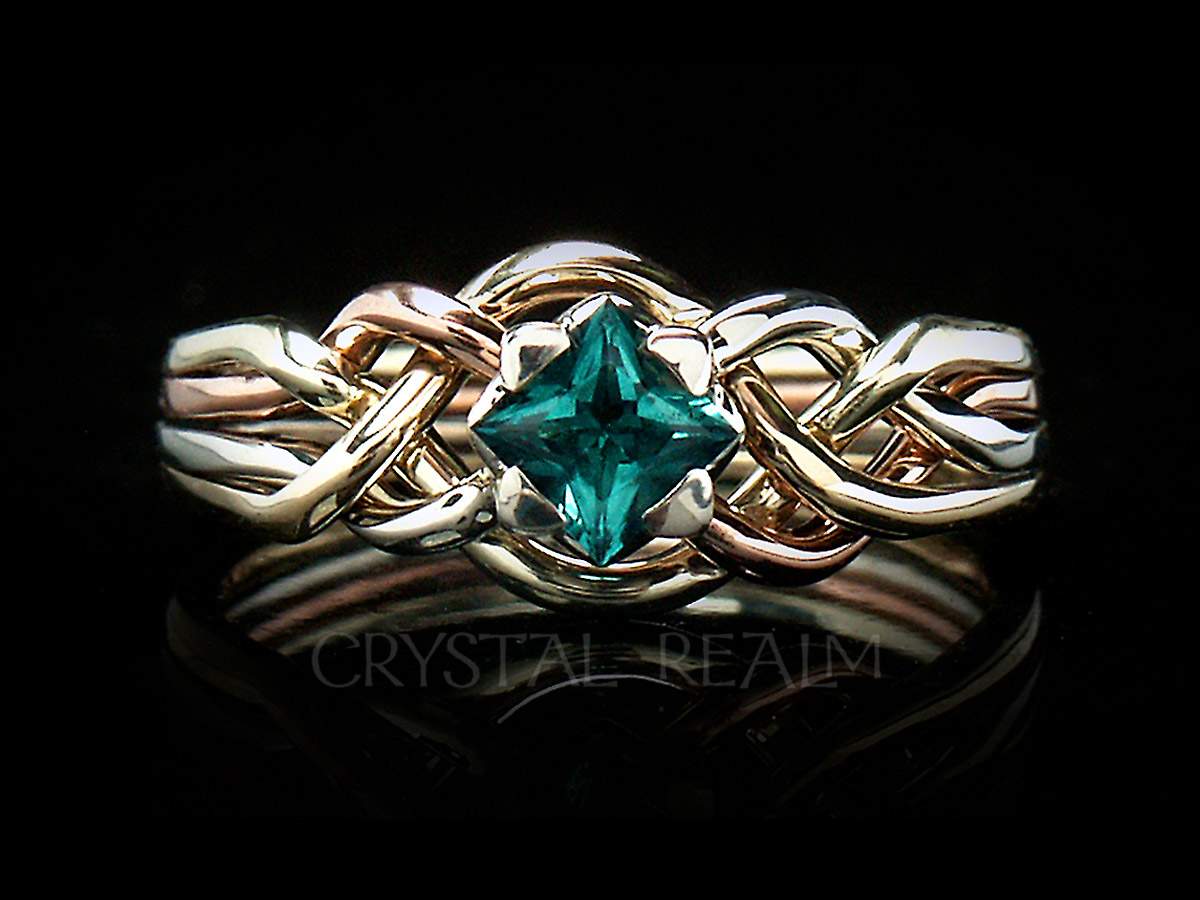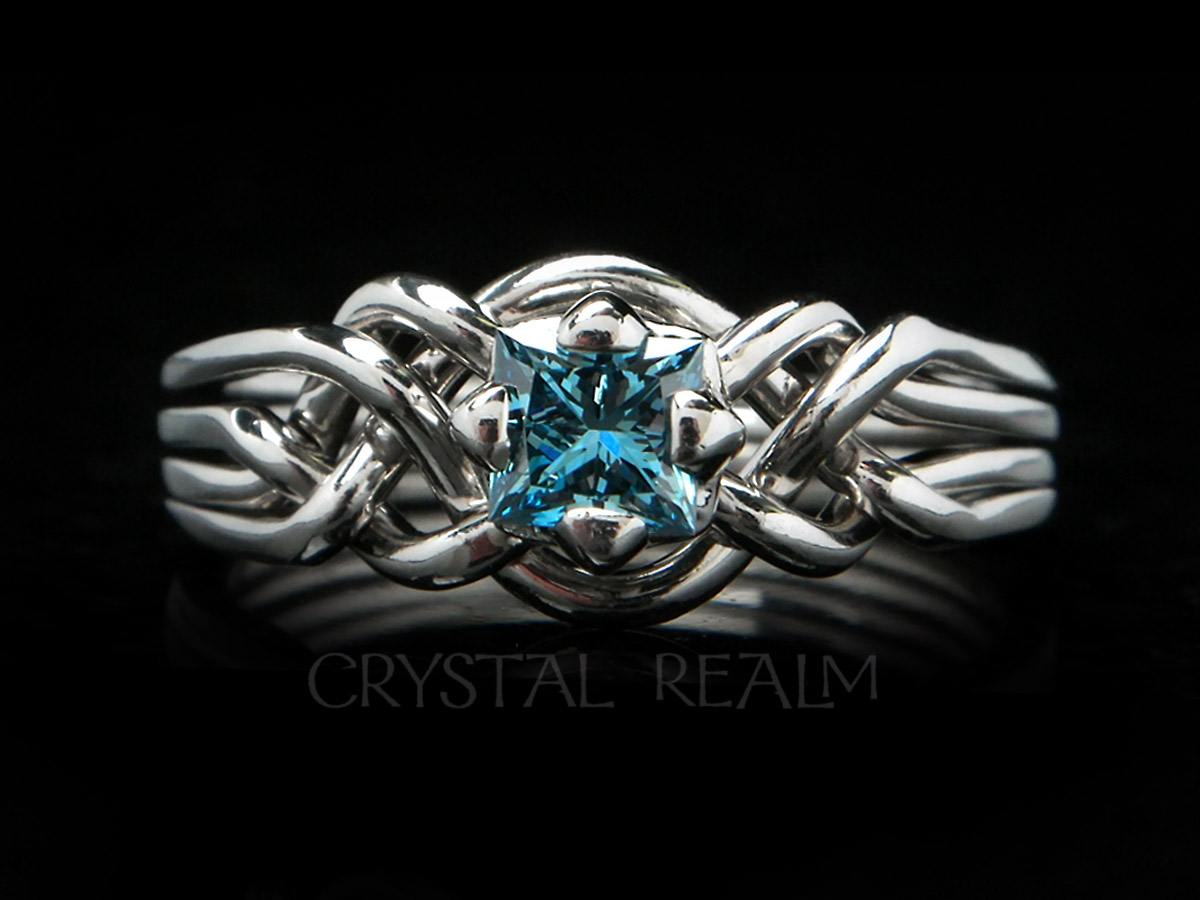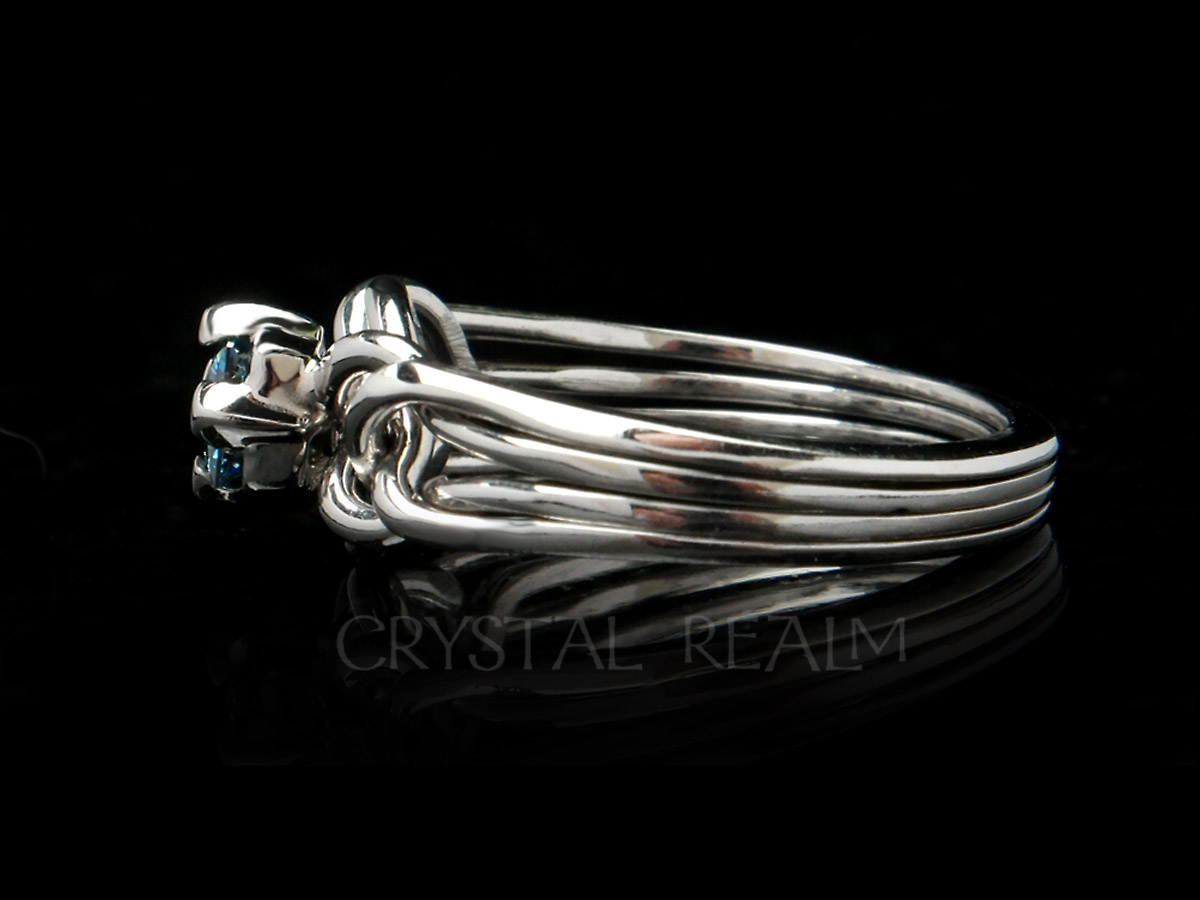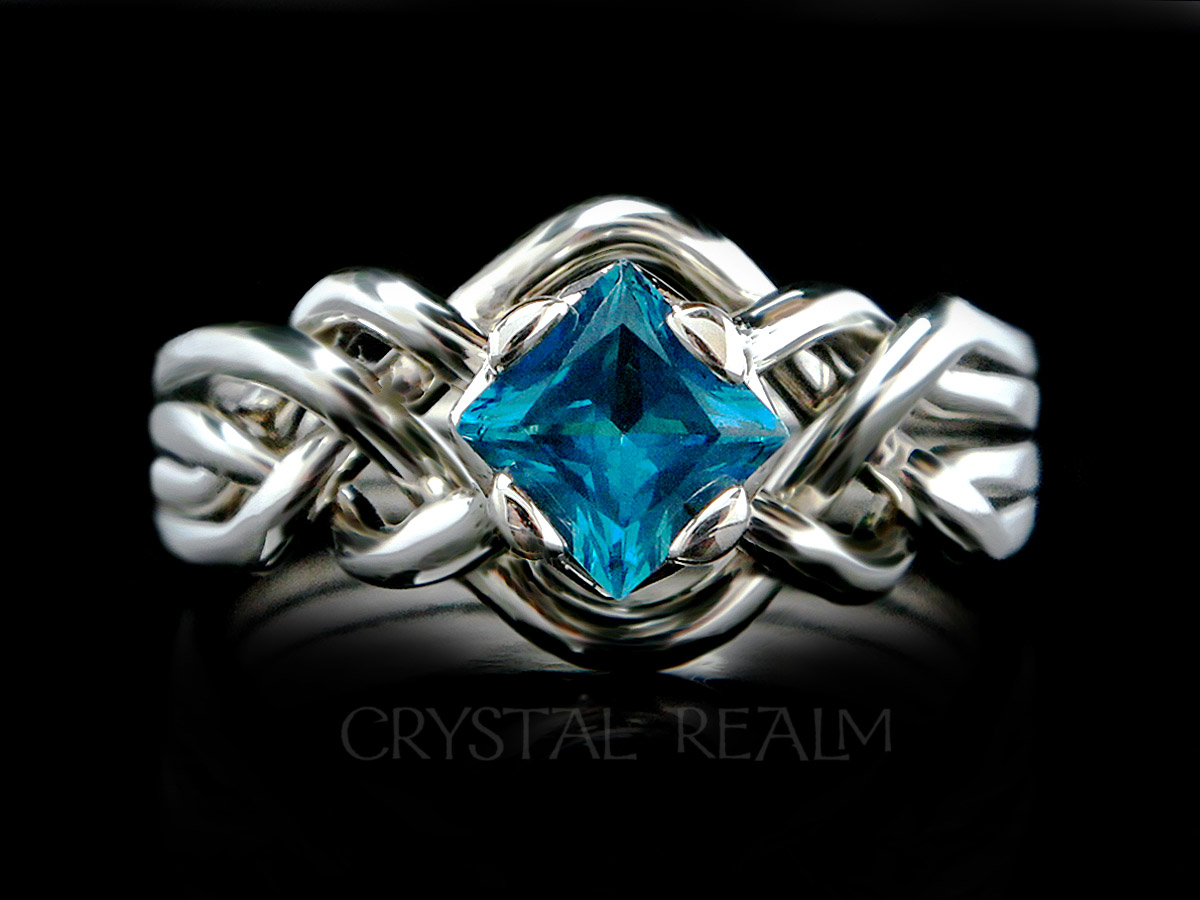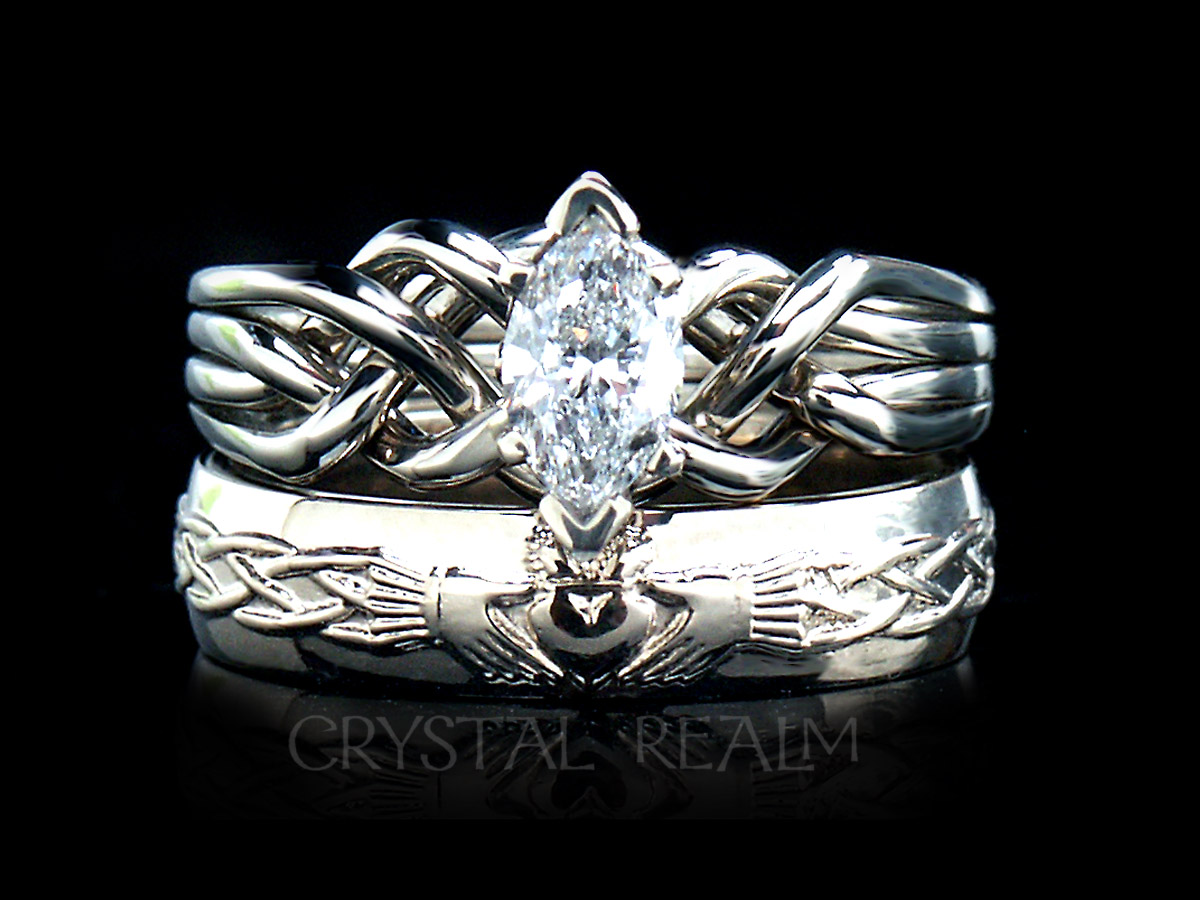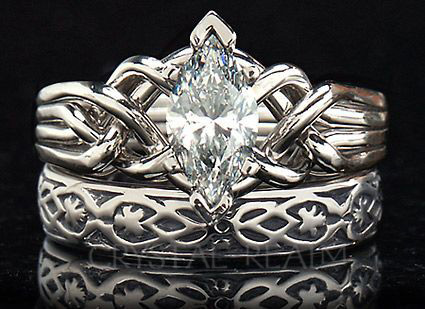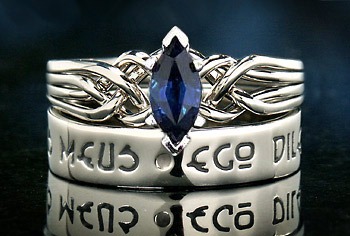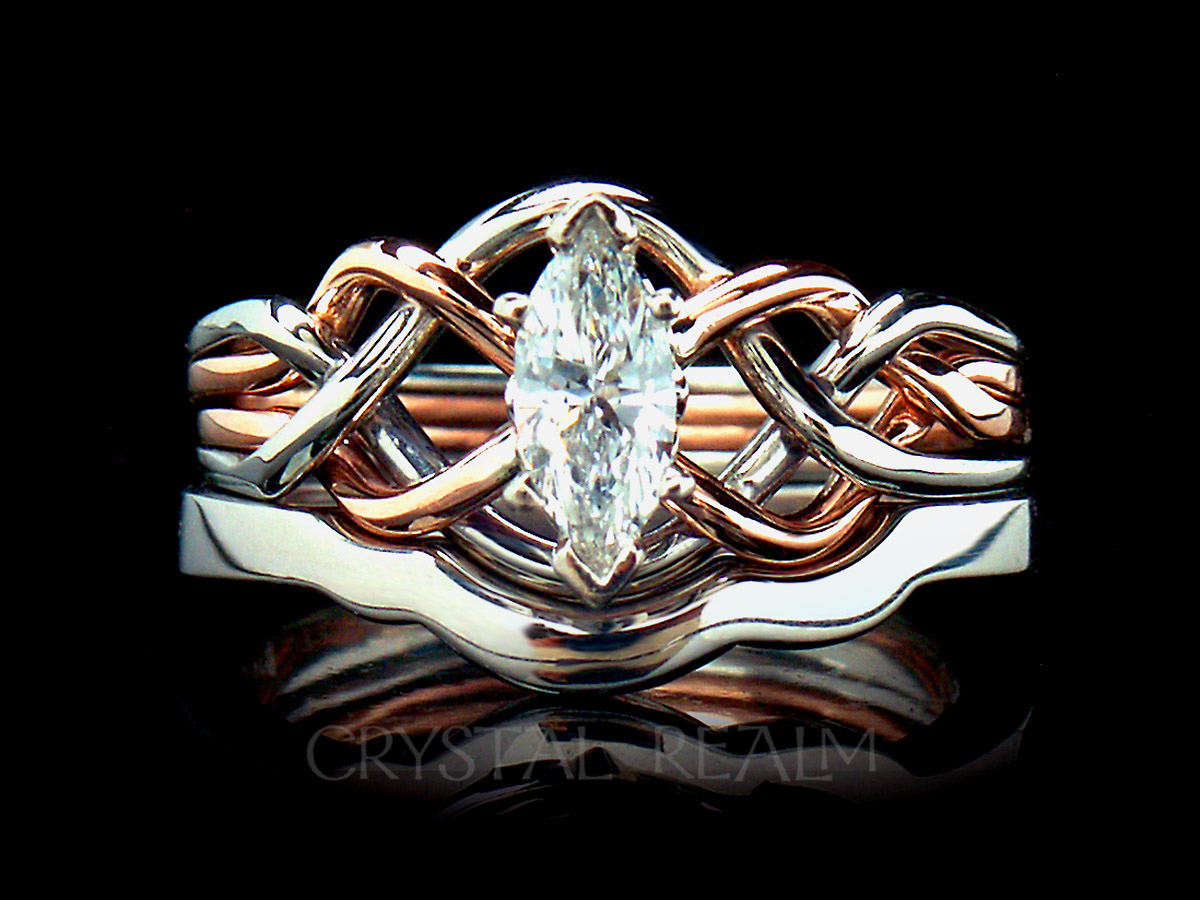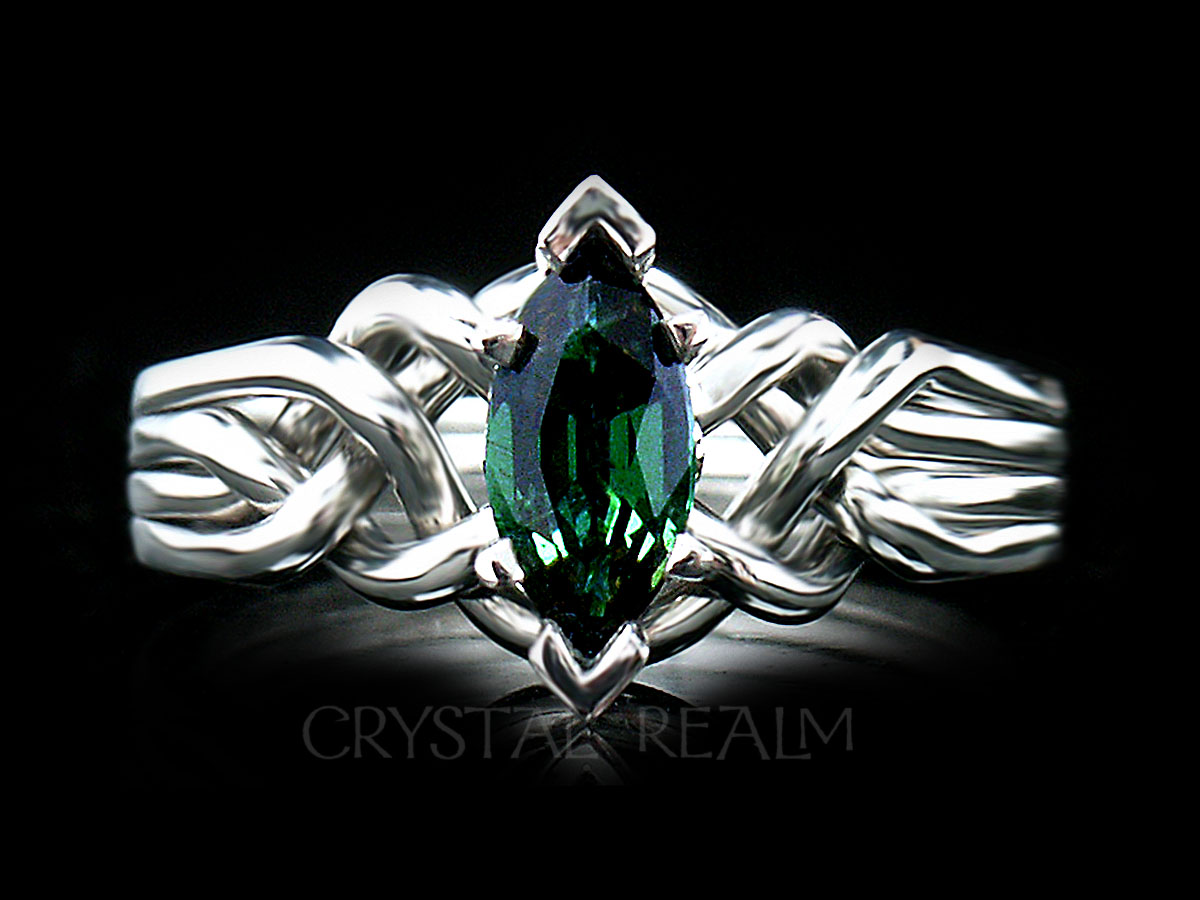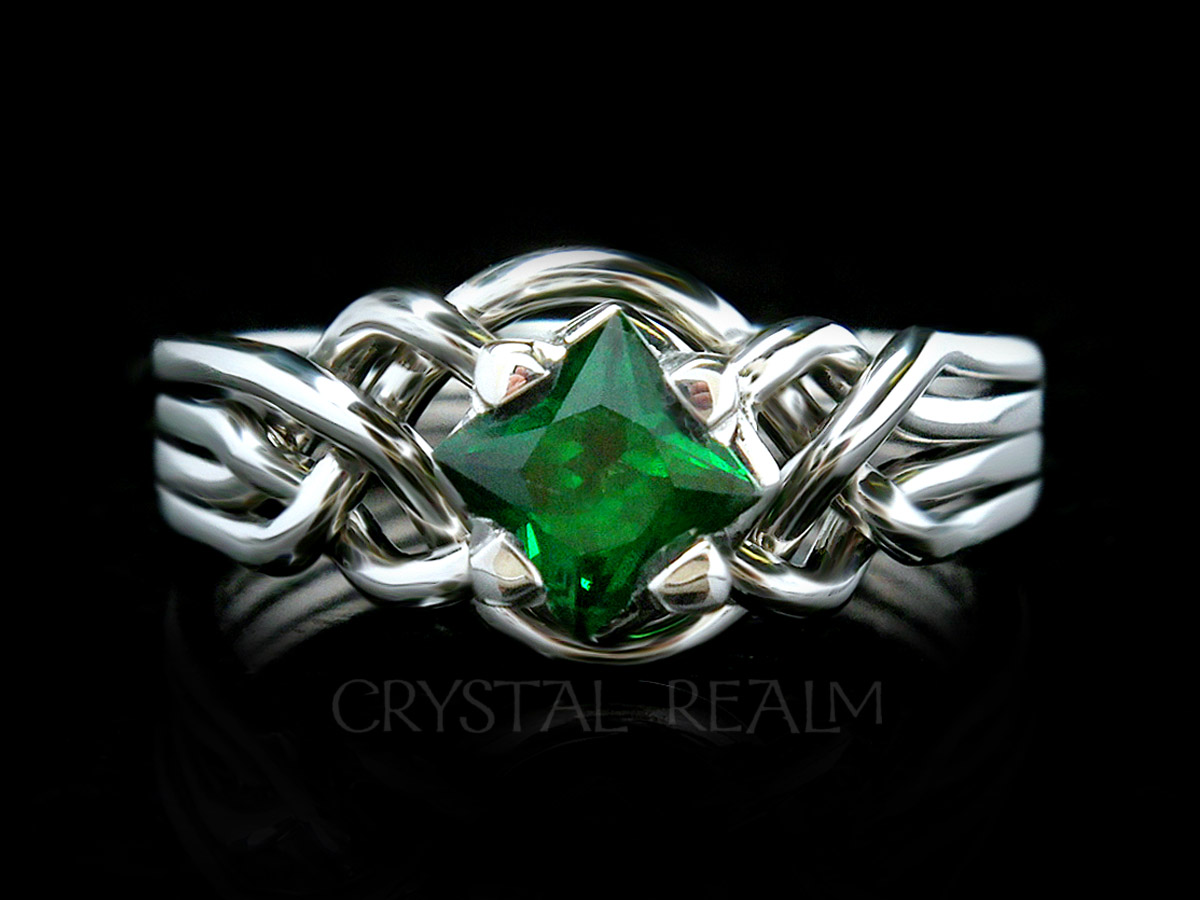The modern diamond industry measures diamonds on several metrics that may be familiar to you: cut, clarity, color, and carat weight. They are known as the Four C’s. Below is a mix of “industry standard” information about the Four C’s along with how we think about the Four C’s – and a few other variables – here at Crystal Realm. You will learn how, when we select a diamond for your engagement puzzle ring, we guarantee that the diamond you get will be beautiful and sparkly on her hand.
Cut
Cut is the most important of all the diamond characteristics, because it is responsible for the sparkle of each diamond. When cuts are beautifully done, it is said your diamond will have immense sparkle. There are five cut grades: Fair, Good, Very Good, Excellent, Ideal. We look for a cut of very good or better. When a diamond is not cut well, light entering the top (table) of the diamond will escape out the bottom or the sides of the diamond. When you have a good enough cut, light that enters the top of the diamond is reflected back and out the top of the diamond, and you will see a great deal of sparkle.
An ideal cut diamond is available only in round and princess-cut shapes. You don’t need to have an ideal cut diamond to have wonderful sparkle.
What people often call cut is really shape
There is a ranking of which shapes of diamonds sparkle the most. Usually when you see this list, the shapes are called “cuts.” They aren’t cuts, they are shapes. The reason the shape is not the cut is that cut is a characteristic of every diamond, no matter the shape. Click on links to see example puzzle rings or photos of the bolded diamond shapes that we use. Yes, occasionally we will set another shape than the ones shown in bold, but then we are using a setting that may be plainer or less in keeping with our “style” of ring.
- Most Brilliant: Round brilliant. Larger round brilliant (shown is a moissanite, but you’ll get the idea!)
- Extremely Brilliant: Oval, Marquise (pronounced Markee) and Pear.
- Very Brilliant: Heart and Princess.*
- Brilliant: Cushion,* Emerald, Asscher* and Radiant.
- Less Brilliant: Baguette cut.
*Square shapes. We don’t currently have photos of cushion or Asscher puzzle rings, but we have set them. Cushion diamonds can be rectangular or square, and we need to use square ones, so we can set them in our ultra-secure Guinevere or Avalon settings.
Why do we use so few shapes?
The reason we usually only use round, marquise, and square shapes is because we are very picky about the settings we use. Most jewelers will tell you to stop by twice a year so they can check the security of the diamond setting. We have clients all over the world, so we can’t do that. We have to make sure that your diamond setting is super secure, and we have only four that meet our standards and our sense of style. The Guinevere and Avalon styles have four prongs that are heavier than most four-prong settings. We find that typical four prong settings are not secure enough to hold a stone. Our six-prong marquise setting has “V-prongs” on the ends. Most marquise settings do not. However, be aware that when a stone has points, it can become tangled in bedding – take your marquise off at night. And the marquise is the only setting that tends to have a potential for a bent prong if you hit it against the washing machine or the garage door, or get it trapped in a door as you close it. It costs money to return a puzzle ring to us to have us replace a stone – no cost for labor, only shipping and the stone – and we prefer that you never have to do that. However, should you damage your ring, we normally provide repairs at no or low cost. We generally charge only for materials we must purchase to repair your ring.
We do ask that you insure all rings of value that you get from us. You would be surprised at how many lost rings we need to replace. I digress, but here is a reasonable solution for insuring your jewelry. Jeweler’s Mutual is the company that insures virtually every jewelry store in the country, and they also offer personal policies. They are reliable and easy for us to work with in the event of a loss (and no, I don’t get a cut!).
Color
At Crystal Realm, we guarantee one of the following color grades for your puzzle ring diamond: D, E, or F color, which are the top three grades of the color range. There is no A, B, or C. D-E-F diamonds are colorless. In fact, at the top end of the range, diamond colors can only be identified by a trained gemologist with the correct equipment. You and I will not discern the difference between, say an D color and an F color. To the “naked eye” they look the same. In fact, you and I will not even discern the difference between an E color and a G color or an H color – the latter two of which are in the near-colorless range – for that matter. On the other hand, if you see a K color diamond, you’ll see a distinct yellowish tint, and at the very lower end of the range, R-S-T, you will observe the diamonds are yellow.
About 2-3 times per year, we ask a client to consider accepting a G or an H color for the marquise diamond we place in the puzzle ring. If we ask you to consider this, it is usually for either a 1/3CT or a 1CT marquise. These sizes in marquise are considerably more rare than the more middling sizes.
Instance #1. If a given diamond matches your needs perfectly in every other respect, and it has G or H color, we may ask you to consider it.
Instance # 2. Sometimes we can save you serious money on a 1CT or larger marquise diamond by selecting G or H color. Diamond prices rise exponentially with carat weight. So a 1CT diamond is not twice as expensive as a 1/2CT diamond. A high quality 1CT-range diamond may be 3x to 6x the cost (ours) of a 1/2CT diamond. We naturally take a smaller markup on the more costly diamonds. Still, we find many of our clients want a diamond at the lower to mid-level of that multiplier range, and we may be more likely to save our client money with a G or H color.
If we wish you to consider a G or H diamond, I will talk to you first about the very diamond we propose putting in your ring and what the rationale for this is. You may accept or decline.
GIA master diamonds used to establish standards for color grading. From left to right, D to T.

Clarity
Typically, we select a diamond with SI1 or SI2 clarity. These are diamonds with no inclusions visible to the unaided eye. What are inclusions? They are the tiny internal blemishes that tell you your diamond is a genuine, earth-sourced diamond. However, you do not want to see any inclusions when you look at your diamond on the hand.
Here is a rough metaphor, loosely based on the knowledge that SI1 and SI2 diamonds represent the highest number of diamonds available. Imagine that a group of people threw 100 darts at a dart board. Maybe one dart would land in the red center of the bulls eye. This would represent an IF, or internally flawless diamond. About 15% of the darts would land on the green of the bulls eye or very close to it. The majority of the darts (about 68%) would be further out in the black and white rays of the board. These are the SI1 and SI2 diamonds. The darts that land around the very outside black row (about 16%) are the lower clarity diamonds in the SI3, I1, I2, I3 range. I range diamonds are usually used in industry.

You might want to skip the next paragraph, if statistics leaves you cold! I’m kind of geeky, so I actually like statistics, though some parts are still confusing to me after five stats classes. If you are a diamond industry expert, you might quibble with my description based on the numbers. But I am merely presenting this information to illustrate, again, that SI1 and SI2 diamonds are more readily available and thus more reasonably priced than higher clarity diamonds. Let’s call this another metaphor.
If you are familiar with statistics, you know the normal curve, a bell-shaped curve which shows the probability distribution of a continuous random variable, in this case, all the rough and cut diamonds in the world. What this means for diamond clarity is that the highest proportion of diamonds are represented by the approximately 68% of diamonds in the yellow area up to one standard deviation from the mean (the center vertical line) in the illustration below. These are the SI2 and SI1 diamonds – no inclusions visible to the unaided eye.
We’ll say the VS diamonds which are one step up the clarity scale are the ones falling in the right hand green area, up to two standard deviations from the mean. These represent approximately 13.5% of all diamonds. VVS clarity diamonds will fall in the right hand purple area up to three standard deviations from the mean (These are about 2.35% of all diamonds). And IF, or internally flawless diamonds, are exceedingly rare, and they occupy the tiny tail in blue on the extreme right of the illustration below. They represent perhaps 0.15% of all diamonds.
Likewise, lower clarity diamonds represent the green, purple, and blue tail on the left side of the illustration. These would be SI3, I1, I2, I3 diamonds.
What does this mean for you? We can save you money by selecting a diamond that is in the yellow center of the range. Since SI2 and SI1 diamonds are more plenteous, they are priced more reasonably than higher clarity diamonds. And since you cannot see any inclusions unless you use a microscope (and don’t – allow the illusion of perfection to exist undisturbed in your mind), your diamond will be equally as beautiful on the hand as a higher clarity diamond.
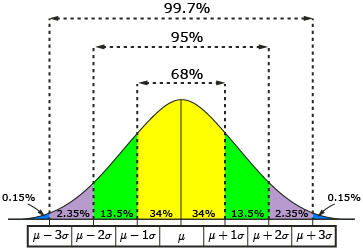
A client told me about going to a brick-and-mortar jewelry store, where a sales person showed him a diamond at 10x magnification (this is the level of magnification that all diamonds are graded on). Then the sales person showed a higher clarity diamond, and to the untrained eye of my client, those inclusions were not visible at 10x magnification. So then the salesperson said, “See, I’ve turned the magnification up to 25x, and this diamond has inclusions you can only see at 25x magnification. This is a MUCH better diamond than the first few I showed you.” This is where the pressure came. “Surely, your fiancée-to-be deserves the very best. This one costs $2,500 more, but why would you consider anything less?”
She does deserve the best, actually, but wouldn’t it make more sense to get more of the diamond characteristics that make it look more beautiful on the hand? Those are cut and color. If you come to me and you want a very high clarity diamond, as some of our clients do, I’ll get you exactly what you want. There can be an emotional boost and sense of pride in owning a more rare diamond. But if you want to save money, understand that the tinier inclusions that you and I could only see at 25x will not translate to greater beauty on the hand. Why? Because once a diamond has no inclusions visible to the unaided eye, it doesn’t get prettier with tinier, harder-to-see-under-a-microscope blemishes.
A client once said to me, “Isn’t clarity what gives the diamond sparkle?” Actually, no, as mentioned previously, sparkle is provided by the cut.
On the other hand, many jewelers purchase “lots” of diamonds, which are bags of diamonds of varying quality. A “lot” of diamonds may have diamonds with really low clarity (the green and purple on the left side of the normal curve), many in the middle SI2 and SI1 range, and a few in the VS or VVS range. They will have colors across the range from yellow or yellowish to colorless. These jewelers must sell all the diamonds in their lot, in order to make their profit. So they may try to sell you diamonds with lower clarity, color, and quality. They may cover an inclusion with a prong of the setting.
We do not purchase “lots” of diamonds. We individually select each and every diamond that goes into one of our puzzle rings. If, when it comes in, it doesn’t meet our standards for beauty and sparkle on the hand, we send it back and order another. If you order a diamond of 0.70CT or greater, we will send you links to videos of the several diamonds we are considering for your ring. This way you can have a part in selecting your diamond. Upon occasion we will also do that for smaller diamonds, but we don’t do it as a routine. We will never, ever cover a visible inclusion with a prong.
Carat Weight
Carat weight is literally the weight of the diamond, not the millimeter size. This is why sometimes two diamonds of the same carat weight will have different measurements in millimeters.
For a long time, the U.S. media reported that the half-carat diamond size is the most popular in the U.S. Now they say a 1CT diamond is the most popular. I notice, though, that the latest report I saw only examined five of the largest cities in the country. Based on Crystal Realm statistics, with clients from rural and city areas in the U.S. and Canada, as well as our overseas customers, I observe the 1/2CT stone is still very popular overall.
However, our results are skewed because most engagement puzzle rings on our site are shown in the medium weight, and this weight will hold a diamond or colored gemstone up to 0.72CT. The majority of our clients want the medium-weight ring, so they request a stone no larger than 0.72CT. We love making rings with larger stones, though, so please ask us for what you want.
When I talk with you about the engagement puzzle ring you want and the diamond or colored gemstone size you want, more than almost any other jeweler, I will talk to you about the weight of the engagement ring. By weight in this case, I mean the thickness of the puzzle ring bands.
Here is the medium weight engagement puzzle ring that will hold up to a 0.72CT stone.
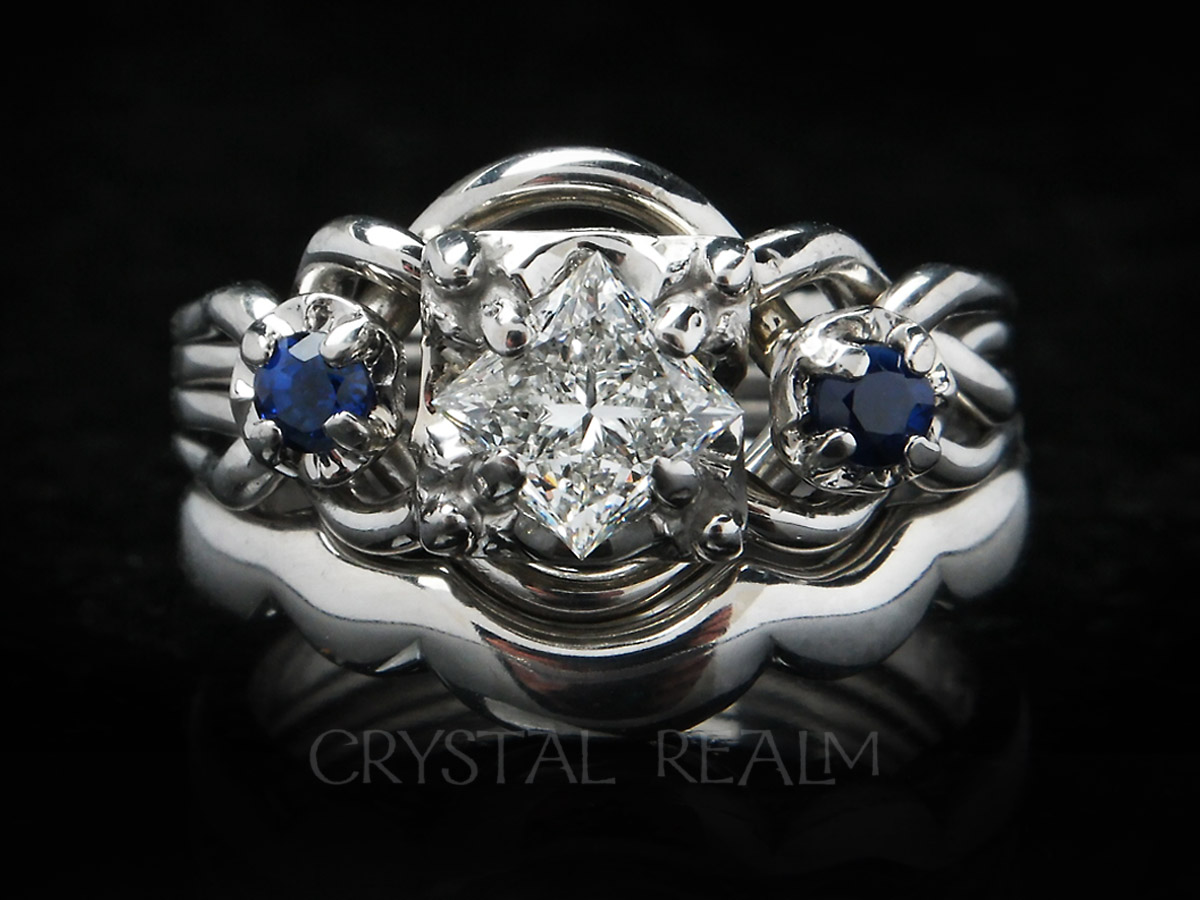
Celtic engagement puzzle ring with 0.60ct center diamond, sapphire accents and optional 2.7mm shadow band
For a 1CT range or greater engagement puzzle ring we offer three weights of puzzle ring.
1. Just-over-medium-weight, which will hold a 0.75CT to 1.10CT stone. Please note that the 1CT range goes from 0.90CT to 1.10CT. The stones we offer you could be anywhere in that range, and sometimes folks choose the lower end of the range, as shown in the photo below. This diamond has exceptional characteristics.
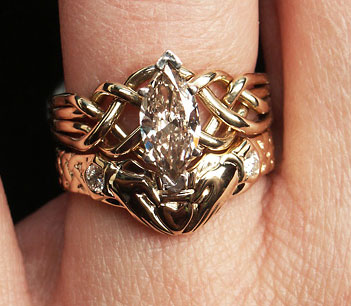
0.93CT marquise-diamond puzzle ring with optional diamond claddagh shadow band. This engagement puzzle ring has an open weave.
2. Medium-heavy weight:
This weight can hold a stone up to approximately 1.5CT
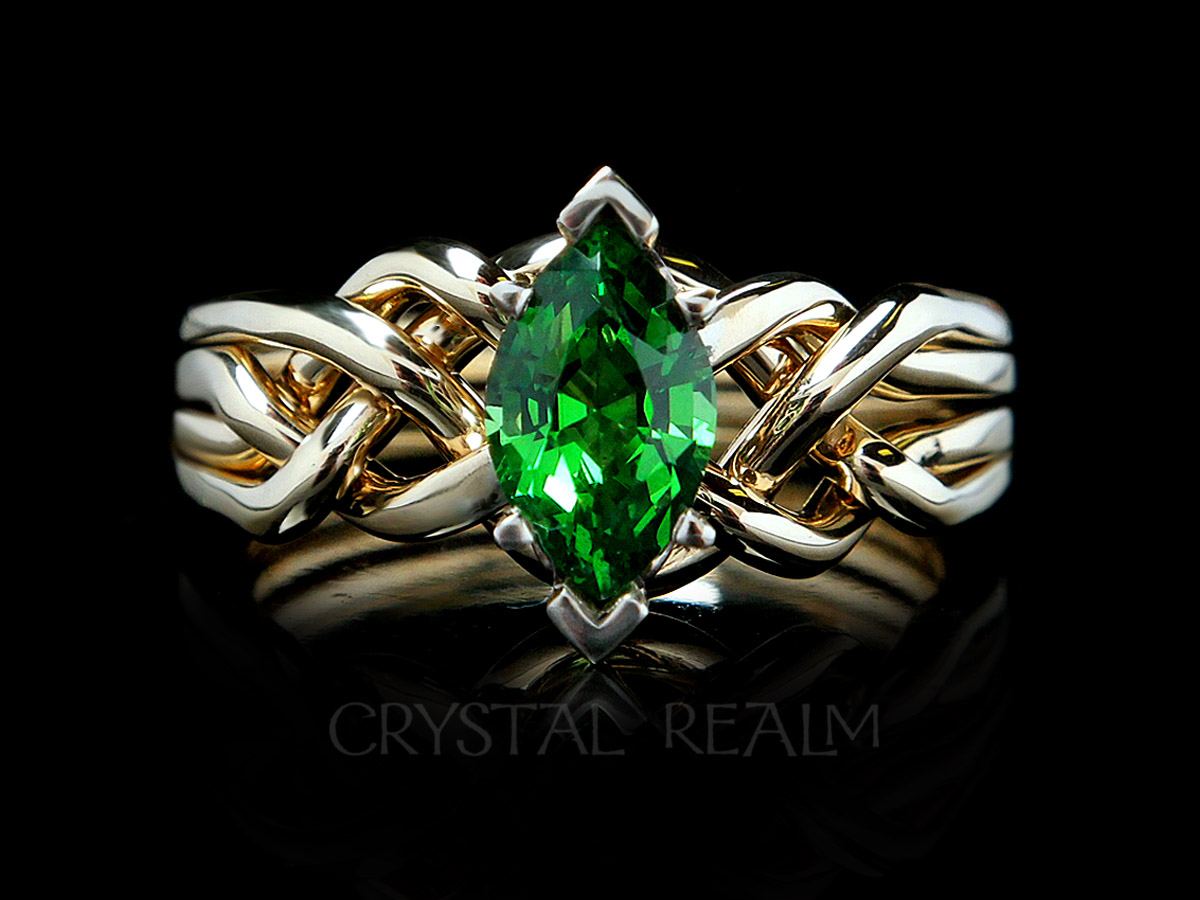
A 1CT tsavorite garnet on a medium-weight 14K yellow gold puzzle ring with 14K white gold setting. This engagement puzzle ring has a standard weave.
Heavy weight, which can hold up to a 2CT stone.

One-carat marquise diamond on a heavy weight four band puzzle ring and paired with a 4mm wedding band shaped to fit with the puzzle ring. This engagement puzzle ring has an open weave. Today we might make a shadow band to go with this ring.
Other diamond characteristics we consider when selecting your diamond
Ratio, bow-tie, source, inspection, sparkle, and spirit
Ratio
For the marquise shape, we consider the length to width ratio. It is said the ideal marquise length to width ratio is 2:1. Occasionally a client will want a shorter, wider stone (such as the marquise tsavorite garnet shown above), but we normally will try to get as close to a 2:1 ratio as possible.
For a square stone, we look for a very square stone. A princess-cut diamond may have a length and width of 5mm x 5.51mm. If we turn this diamond on its corner for a kite orientation (as in the diamond and sapphire Guinevere engagement puzzle ring shown above on this page), it won’t look right. It will look a little off. So we look for a diamond with no more than a 0.20mm difference between the sides, and we prefer no more than a 0.10mm difference. We’ll accept a 5mm x 5.10mm for your square stone. That is 1/10th of a millimeter difference, or 10/100ths of a millimeter. We might consider a 5mm x 5.2mm. But we won’t tolerate a difference larger than that.
Bow-Tie
With marquise diamonds, we make sure your diamond does not have significant bow-tie. This is an optical illusion occurring in some marquise diamonds resulting from the cut. It appears as a black “bow-tie” across the center of the diamond. It isn’t “real” in that when you look at the diamond from another angle, it disappears. Some jewelers say a tiny bit of light gray bow-tie can give a diamond character, but we reject many marquise diamonds as we search for yours, as we don’t want your diamond to appear to have a dark band in the shape of a bow-tie across your diamond from any angle.
Source
We work almost exclusively with the diamond house that our puzzle ring maker has been working with since the early 1970s. This supplier provides ethically sourced diamonds and maintains tight control over their pipeline of diamonds. We are very proud to be able to offer you diamonds that you can feel good about acquiring and wearing.
When buying a diamond, one of the most important things is to know your source. What our source says we will get, in terms of diamond quality, is what it delivers. This means that we don’t tend to be surprised when your diamond arrives. Our source guarantees that all diamonds of 0.37CT or 3/8ths carat are certified diamonds, include a diamond certificate, include one year of free loss protection, and have a serial number laser inscribed on the diamond.
For diamonds lower than 0.375CT, which on our site are listed as 1/3CT, we are often able to offer certified diamonds with the same benefits as the larger diamonds. However, we use a little more leeway in ordering 1/3CT diamonds. Although we don’t carry many diamonds in stock, we sometimes purchase well-priced 1/3CT diamonds without much regard for clarity, say, as long as we can’t see any inclusions in them. This habit has resulted in occasional happy surprises, such as recently finding a diamond with SI3 clarity with phenomenal sparkle. One customer said to me, “I would never want an uncertified diamond, because they are junk!” This is not true if you purchase a non-certified, 1/3CT diamond from us. We will use our same standard of beauty and sparkle on the hand.
Inspection
If you are choosing a diamond of 0.70CT or above, we will be happy to send it out for your inspection prior to setting it in your ring. We will place an authorization on your card (possible with credit but not debit cards) in the amount of half the cost of your ring plus round-trip shipping. When we get it back, you will either get your deposit back, or if you are happy with the stone, we’ll apply the deposit to your ring.
For smaller diamonds, we prefer to place the diamond in your ring and send it out finished to you. If you are not thrilled, we’ll take it back and replace it with another diamond.
Sparkle
We insist that your diamond must sparkle. Yes, we covered sparkle under cut, but one more thought is in order. We value sparkle over color and clarity. If we carefully select your diamond, and it doesn’t sparkle beautifully, we will send it back and order another. Since our diamond source is trustworthy and they make it easy for us to characterize the diamonds we select, we have only done this once in the last almost 15 years. This is how we send out diamonds that our clients are happy with.
Spirit
I am intrigued by folklore, which can be defined as, “the traditional beliefs, customs, and stories of a community, passed through the generations by word of mouth.” On a less charming note, Merriam-Webster also suggests folklore can mean, “an often unsupported notion, story, or saying that is widely circulated.” Supported or not, through the ages, folklore the world over has held gemstones in high regard, attributing various powers to gemstones. Whether they have powers or not is apparently above my pay grade ; ) though I cherish their allure. My folkloric thought, entirely unsupported by evidence but making my work more fun, is that I think of looking for a diamond with a “friendly spirit” inside it. I think of this spirit as expressing itself in the magnificence of your diamond.

